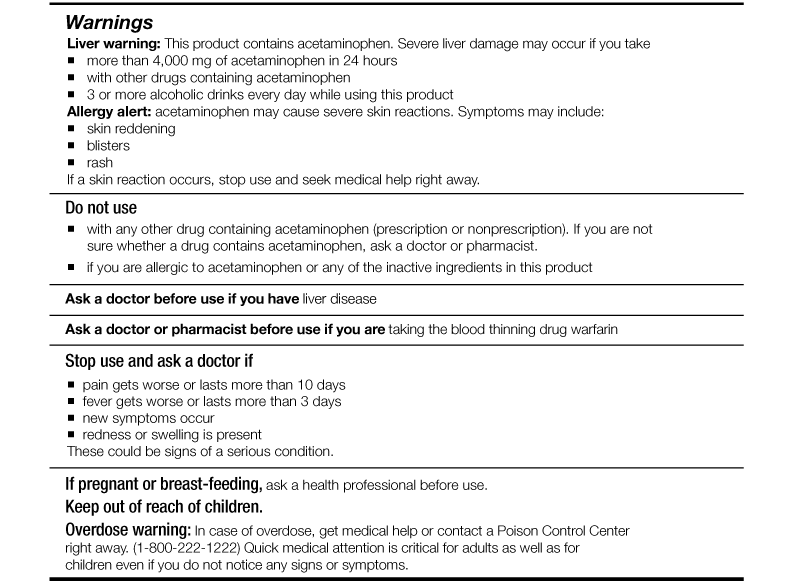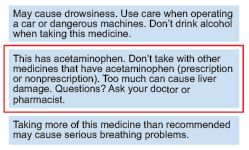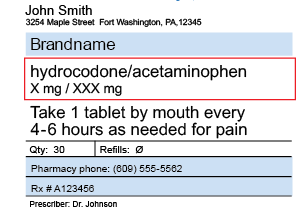Teens want information at their fingertips. The Drug Facts label on over-the-counter (OTC) medicines is just that—information at your fingertips to help you use medicines safely.
The Drug Facts label explains:
- Active ingredients (the ingredients in the medicine that makes it work)
- Uses
- Warnings
- Directions
- Storage or other information
- Inactive ingredients
The graphic below can show you how to read a label and the important elements that will help you use acetaminophen and other medicines safely. Simply touch/roll over each section of the drug facts label below to learn more about what each section tells you.
Over-the-Counter Label


Active Ingredient
This section lists the ingredient or ingredients that make the medicine work. For example, the active ingredient is what helps your fever go down, reduces your pain, or relieves your cough. It is especially important to pay attention to this section if you are taking more than one medicine—whether OTC or prescription—to make sure you are not taking too much of the same active ingredient. Too much of an active ingredient can be harmful.

Purpose
This section tells you what type—or category—of medicine it is, such as an acid reducer or antihistamine.

Uses
This section tells you what symptoms or illnesses you can expect the medicine to treat. You should only use products that treat the symptoms you have. If you are using more than one medicine, pay specific attention to the active ingredients so you don’t accidentally take too much.

Warnings
There are times when you should not take a particular medicine. The warnings section explains these times, and also tells you when a healthcare provider needs to be consulted, as well as when to stop taking a product.
The “warnings” section also lets you know if there might be side effects to a medicine and if you should be cautious during any particular activities, such as driving. This section also may tell pregnant and nursing women not to use certain products unless they’ve talked to their healthcare provider and reminds parents and other caregivers to keep medicine out of the reach of children.

Directions
A medicine’s directions tell you exactly how and when to take a medicine. Remember, you should never take more than the Drug Facts label says, and you should never take a medicine more often or for longer than the label says unless told to do so by your healthcare provider. Taking more of a medicine or for longer than directed can be dangerous.
Be very careful when giving medicine to children. Read and follow the age or weight instructions on the label and always use the correct measuring device when administering liquid medicines. If you have any questions, talk to your child’s healthcare provider.

Other Information
This section tells you other important information you should know about a medicine, such as where to store it. Take a look at the labels on the medicines you have in your house and make sure you are keeping them in the right place. Most medicines should be kept away from heat and humidity. And remember what you learned in the “warnings” section: Regardless of the medicine, always keep medicines out of the reach and sight of children.

Inactive Ingredients
The inactive ingredients section includes important information, especially if you or a loved one has a known allergy.

Questions?
Always talk to your healthcare professional if you have any questions. You can also call the toll-free number listed in this section.
Source: Acetaminophen Awareness Coalition: www.KnowYourDose.org
Prescription Label

Warnings
Warnings are specific to the medicine you are taking. Always read the warnings before taking your medicine.

Expiration Date
Medicines expire. You should not take a medicine after the expiration date.



Pharmacy Information
Your local pharmacy name, address and phone number and the name of the doctor that has prescribed your medicine will be listed. Contact your pharmacist if you have any questions about your prescription.
Your prescription (Rx) number is unique to your medicine and helps the pharmacist ensure you go home with the correct prescription.

Source: Acetaminophen Awareness Coalition; www.KnowYourDose.org
Explain to older teens the importance of checking the label when selecting a non-prescription (OTC) medicine and again each time before it’s used. The Drug Facts label will help them to:
- decide if they have chosen the right medicine for their symptoms
- understand the dosing instructions
- be aware of any medicine warning that might apply to them
Reinforce with younger teens the importance of following the instructions about medicines from their parent or guardian.
Other resources or tools are available to help you help teens to be “Medicine Smart.” These include:
- the medicine information sheet included with every prescription
- a pharmacist
- reputable online resources on medicine safety, www.medlineplus.gov, for example
Remind teens that even though OTC medicines are readily available, it’s important to remember they are serious medicines that need to be taken with care.
When using a prescription medicine, teens should read and follow the written medicine information provided by the pharmacy and the healthcare professional’s instructions.

